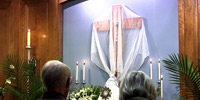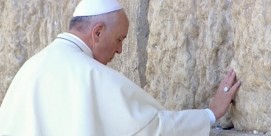In This Episode << SLIDE LEFT TO SEE ADDITIONAL SEGMENTS
Sistine Chapel Anniversary
LUCKY SEVERSON, correspondent: Of all the magnificence of the Vatican, there is likely nothing of more artistic consequence than the Pope’s own personal chapel within the Vatican—the Sistine Chapel, more specifically its ceiling. It took Michelangelo Buonarroti 4 long years to paint the famed ceiling and 500 years later it stands for many as the most powerful portrayal of man’s relationship to God. Art historian Bridget Goodbody.
BRIDGET GOODBODY: It wouldn’t be too hard to say that it’s the most important piece of art that’s ever been made.
SEVERSON: Important not only to Catholics, but to Christians of many denominations. In California, at the Menlo Park Presbyterian Church, Pastor John Ortberg has based much of his writing for books and sermons on Michelangelo’s images.
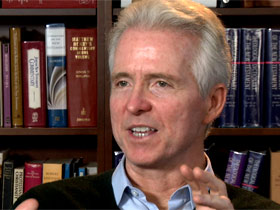
PASTOR JOHN ORTBERG: On the ceiling you have this image that is glorious, transcendent, splendid, overwhelming, enormous. I mean, you just stand in there and you’re kind of bowled over by it.
SEVERSON: Michelangelo depicted the Biblical Creation story from the beginning through man’s fall from grace. When it was first unveiled to the public in 1512, the artist Giorgio Vasari said: the whole world could be heard running up to see it, and indeed, it was such as to make everyone astonished. At Harvard Divinity School, for many years the coordinator of the Theological Opportunities Program for Women was Elizabeth Dodson Gray.
ELIZABETH DODSON GRAY: I think it was enormously significant because of the effect it had upon people encouraging them to think of God as male through 500 years. I don’t know how much they thought of God as male before the Sistine Chapel. I do know that in Judaism the Jews were absolutely discouraged, as you know, from doing any graven image, and so they were prohibited from drawing pictures of the Almighty, the Creator.
SEVERSON: Up until then, God was mostly depicted in non-naturalistic imagery, as a spirit, an abstract form, or as a dove hovering in the sky— essentially an impersonal diving presence. Michelangelo’s ceiling changed all that.
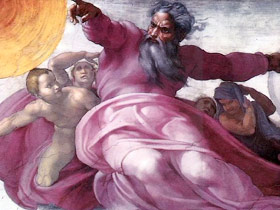
GOODBODY: It created an image of God that was human and superhuman and so the idea, if you personify God and you think about God as a white man with long white hair and a long white beard, chances are the picture is where you got that idea.
SEVERSON: It was the Warrior Pope, Julius the Second who commissioned Michelangelo to paint the ceiling of the Sistine Chapel, an odd request considering that Michelangelo was a sculptor who had very little experience as a painter.
GOODBODY: And Michelangelo didn’t want to do the ceiling. (laughing) He really wanted to continue to sculpt, and Julius insisted that he do it.
PASTOR ORTBERG: He actually wrote in his journal, “I’m no painter.” And it wasn’t particularly modesty. I don’t know that he was a real modest guy. It was just stating a fact. He was a sculptor, and yet he had been commissioned to do this work. And it came at a pretty substantial personal cost.
SEVERSON: For hundreds of years it was thought that Michelangelo painted the 65 foot high ceiling while lying on his back on scaffolding. But historians now know that wasn’t so.
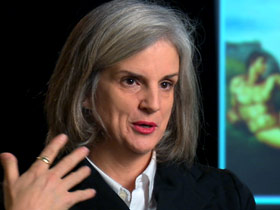
GOODBODY: He was standing up. Getting paint in his eyes and (laughing) almost going blind.
SEVERSON: One reason Michelangelo’s ceiling has withstood the trials of time is the method he used to paint it, a process known as fresco where the paint is applied to wet plaster. It took a lot of painful experimenting to make it work. Its central theme is humankind’s need for salvation, which is portrayed in nine scenes from the Book of Genesis.
GOODBODY: You have the drunkenness of Noah, you have the 40 days and 40 nights and representations of the floods and Adam and Eve being expelled from the Garden. Then there’s the creation of Adam and the creation of Eve and the creation of the Earth and the sun and the moon. That last image you find yourself in front of the altar piece, which is the Last Judgment and which very famously has those who are going to heaven on one side and those who are not on the other.
SEVERSON: The most iconic image of Michelangelo’s fresco work is the scene where God appears to be reaching down to Adam, their fingers almost touching.
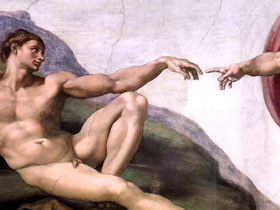 PASTOR ORTBERG: His eyes are open and it appears that he is alive, but some folks have said what’s taking place in that moment is not so much the impartation of biological life as that which makes us most human, or what the Bible talks about as being “created in the image of God,” and so, to have spirit, to be a soul, to be able to be connected with God, to be a moral agent. All of that’s what is happening at that moment.
PASTOR ORTBERG: His eyes are open and it appears that he is alive, but some folks have said what’s taking place in that moment is not so much the impartation of biological life as that which makes us most human, or what the Bible talks about as being “created in the image of God,” and so, to have spirit, to be a soul, to be able to be connected with God, to be a moral agent. All of that’s what is happening at that moment.
SEVERSON: Art historian Goodbody says she paid an extra admission fee so she could spend two hours in the Sistine chapel studying the ceiling all by herself.
GOODBODY: It’s such a great painting because you have sort of God very energetic and the wind pushing his hair back and sailing through the… he’s very determined. You know, he’s just created the universe, after all. Now he’s gonna, you know, humans are gonna rise up, he’s gonna make man in his own image.
SEVERSON: This is the part where Elizabeth Dodson Gray, the feminist theologian, and author of three books, takes exception.
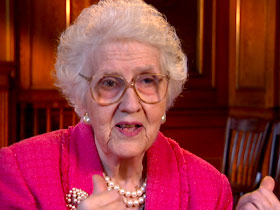 ELIZABETH DODSON GRAY: It was a great picture, bad theology, very bad theology. “God created man in His own image.” Okay? And if we say that a picture’s worth a thousand words, and truly the picture in the Sistine Chapel is probably worth a thousand words, if you understand the sociology of knowledge as we now do, what really makes a difference was the male of the species created God in his own image. So actually the energy of creation went up, rather than down.
ELIZABETH DODSON GRAY: It was a great picture, bad theology, very bad theology. “God created man in His own image.” Okay? And if we say that a picture’s worth a thousand words, and truly the picture in the Sistine Chapel is probably worth a thousand words, if you understand the sociology of knowledge as we now do, what really makes a difference was the male of the species created God in his own image. So actually the energy of creation went up, rather than down.
SEVERSON: What do you mean when you write about the Narcissus effect with Michelangelo’s ceiling?
DODSON GRAY: Well if you look at the Caravaggio picture, when Narcissus looks in the water and only sees his face. And the sentence I wrote is that the male of the species saw only himself when he looked in the cosmic pool of ultimate mystery.
SEVERSON: More traditional Christian views have not represented God in the female form, but in Pastor Ortberg’s view, women have been an important and positive part of God’s message.
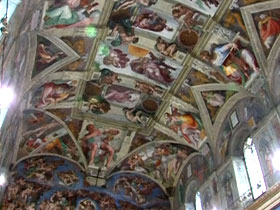 PASTOR ORTBERG: Oh I think it’s unquestionably a point worth noting. Sometimes in the scripture there are feminine analogies used. Jesus says at one point, “You know how often I would have gathered you like a mother hen gathers her chicks but you would not let me.” So I think one of the hard things is, because in the Bible we talk about God as Father, people can think about God as masculine the way that a human being is masculine.
PASTOR ORTBERG: Oh I think it’s unquestionably a point worth noting. Sometimes in the scripture there are feminine analogies used. Jesus says at one point, “You know how often I would have gathered you like a mother hen gathers her chicks but you would not let me.” So I think one of the hard things is, because in the Bible we talk about God as Father, people can think about God as masculine the way that a human being is masculine.
SEVERSON: Goodbody, now the curator of Artintelligence.com, sees a modern resonance for Michelangelo’s imagery.
GOODBODY: I’ve been spending a lot of time thinking about it and as I go through the scientific imagery, I seem to find Michelangelo’s creation of Adam picture frequently displayed. You know, this sort of God giving energy to a test tube baby or a DNA molecule. It’s pretty tricky when you start to get into this conversation about creation. And who creates? Was it God that’s creating it? Or are we at a point in history and in time when we’re creating life?
SEVERSON: Pastor Ortberg believes the significance of Michelangelo’s masterpiece is the message it imparts.
PASTOR ORTBERG: I think part of what gave art so much power for Michelangelo was not just the need to shock folks that might become complacent, but the vision of a transcendent order and the idea that we live in a world that has meaning and has moral beauty, and that human life is about something, and wanting to point people to something beyond themselves, wanting to point people to that hope.
SEVERSON: After nearly 500 years, the Sistine Chapel’s ceiling was getting dimmer with age, but it has since undergone a complete restoration, preparing it for the 21st century and more generations to come.
For Religion & Ethics NewsWeekly, I’m Lucky Severson.


